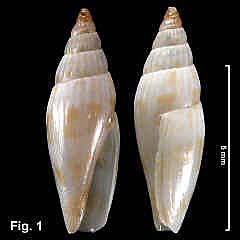|
|
|
|
|
Page not in use. Name has a space after it
Parviterebra brazieri (Angas, 1875) Description: Protoconch of 4 whorls, last ½ whorl axially ribbed. Shell slender, whorls rounded, aperture ½ shell length. Sculptured with weak or very weak axial folds, from 15 to about 50 on penultimate whorl; more numerous on last whorl but restricted to upper quarter. Base with about 15 fine spiral cords. Outer lip smooth, not thickened internally or externally. Columella smooth, with thin callus extending onto body whorl. Siphonal notch broad, no siphonal canal. Colour white, with broad spiral brown bands broken up into rectangular patches or axial zigzag lines; 2 bands visible on spire whorls, 3 on last whorl. Size: Up to 13 mm in length. Distribution: Endemic to Australia; Yeppoon, Queensland, around southern Australia to south-western WA, including Tasmania. Habitat: Subtidal, down to 77 m; occasionally found in beach washup. Uncommon. Comparison: See P. trilineata. Synonymy: Synonyms are Mangelia harrisoni Tenison-Woods, 1878 and Olivella australis Tenison-Woods, 1878. An earlier available name is Euryta pulchella A. Adams & Angas, 1863, which was considered a homonym and replaced by Terebra angasi Tryon, 1885. Remarks: NSW shells have about 15 axial folds on the penultimate whorl, and about twice that number on the shoulder of the body whorl. Shells from WA have more numerous and finer folds. Fig. 1: Off Washaway Beach, Middle Harbour, NSW (C.372859) |
